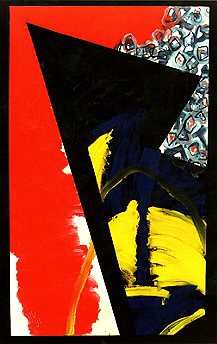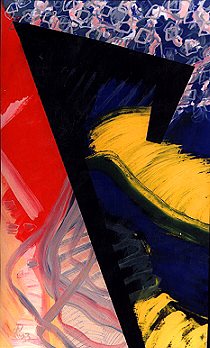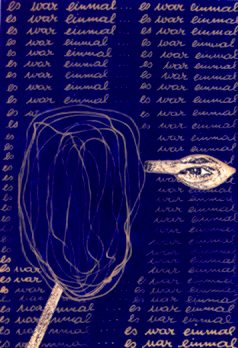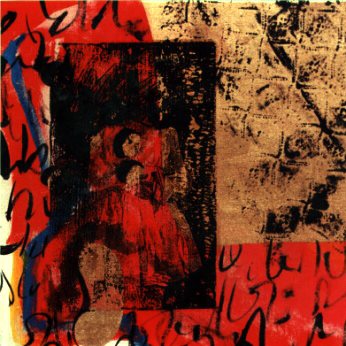|
(Back to summary all artists)
INFO ARTWORKS
Click below on artwork for more info artwork and to see more big
|
INFO ARTIST
Annelore Kuryszczuk
Born
Residence
RThe Netherlands
Education
Royal Academy of Fine Arts, Antwerp, Belgium 1974 -1978
Masterclass Milan Kunc, Amsterdam, NL 1995
Description
Anne-Lore Kuryszczuk’s work several aspects become immediately notable. One is that her work exudes an enormous clarity and another aspect is a reassuring surveyability or in any case, an aspiration towards this end. Indeed, it is remarkable how little empathy the observer needs to participate in this process. One presumes that she enjoys experimenting with elemental facets such as structure, line, direction, contrast, texture and light. And if we feel as if she is taking us on a journey to the world of Mondriaan and his artist descendants by the use of variability and interchangeability of features of these original great painters, there is perhaps another aspect to be aware of. And that is the search for truth, harmony and purity embodied in her art. Another impression one gets when viewing her assembled work is that one finds himself in a kind of binary world. Certainly not the ever present world of soft- and hardware, the predictable logic of electronics, calculations, numbers, grids and pixels. On the contrary, hers is both a world of perceived sensitivity and polarity discovered in which this duality on many levels intuitively and manually are composed into organic image lines and frameworks. Indeed this duality which exists in her work is both elemental and fundamental. After all, it ultimately embodies the essential complement of all that is present: of the one which always bears the other out of a necessity for existence. But this existential precept is rather presented by the artist on the level of material and structure: there is no foreground without a background, no equality without inequality, etc. That is a prerequisite on this level of observation in order to be seen at all and indeed as it’s been said in German: “Was in die Erscheinung tritt, muß sich trennen, um nur zu erscheinen.” (what occurs in the appearance must just separate to be able to appear again). And so it seems a sparseness of modality if not of features. It goes without saying that it’s impossible to create a work of art with only one feature. Where there’s form, there’s scale, where there’s colour, there’s dimension, if there’s smoothness, there’s also texture, material then structure and so it goes on and on. But, one can try to achieve this effect. Confronted with such a consistent use of white and ultramarine, it’s practically inevitable that one thinks of the French artist, Yves Klein, and his IKB. There will also undoubtedly be viewers who associate this work with the glazed terracotta of the Renaissance artist, Luca della Robbia, in spite of the abstract nature of her work. So powerful is the use of white and blue wielded that this is the dominant force over any figuration. But let us try to move beyond this sort of historical art association (since it is perhaps too gratuite) and take pause at the implications of this white and ultramarine and attempt to ascertain the effect these colours have on our capacity for observation and experience. And so one could reach the conclusion that “white is not a colour” provided that you believe in the idea of reçue (as my 6-year-old son does). In this sense, one might view Anne-Lore Kuryszczuk’s work in fact as being monochromes. (Here the word binary crops up: colour/no colour). Furthermore, one can philosophize endlessly about this but to continue on a more specific level, namely from the earlier-mentioned Klein, who claims that when looking at blue, at first there’s nothing, followed by a deep nothing and afterwards, an absolute depth. At this, one could reach the conclusion that Anne-Lore Kuryszczuk’s work, depending on the degree of depth to which one allows himself to be affected by the colour blue, can be experienced as one dimensional creations (lines) but also two dimensional (depth). These paintings appear to be challenging us to ask ourselves how best to view them: as lines as in a text or as planes as in an image. (And as noted earlier, it’s also possible to view them as volumes). Most paintings are usually observed by letting one’s eyes roam freely around the structure created by the artist. Most texts are usually looked at by literally following the lines. This is done because a definite structure has been presented. Not until we follow the words line by line do we comprehend what the writer wishes to express in his composition. Adapting this point of view it might seem that Anne-Lore’s work would be conflicting. But, on the other hand, one seldom finds in a single glance just what the artist wishes to express. The observation of a painting or drawing is a repetitive process of synthesis and analysis: the first step is to view the overall image in a single glance and then to allow one’s gaze to glide over the paths where our eyes choose to take us. This process will continue and repeat itself. Most paintings are “deciphered” in this way. One gets the impression that Anne-Lore Kuryszczuk’s paintings are an invitation to “decipher” whereby unimpeded scanning coupled with following the lines with one’s eyes result in a between-the-lines observation. This is done in precisely the way one looks between the blinds. Sharon Slebos, English translation. Marc Geerards, Dutch text.
Mondriaan and Kuryszczuk: interfacing image lines
In Anne-Lore Kuryszczuk’s work several aspects become immediately notable. One is that her work exudes an enormous clarity and another aspect is a reassuring surveyability or in any case, an aspiration towards this end. Indeed, it is remarkable how little empathy the observer needs to participate in this process. One presumes that she enjoys experimenting with elemental facets such as structure, line, direction, contrast, texture and light. And if we feel as if she is taking us on a journey to the world of Mondriaan and his artist descendants by the use of variability and interchangeability of features of these original great painters, there is perhaps another aspect to be aware of. And that is the search for truth, harmony and purity embodied in her art.
Another impression one gets when viewing her assembled work is that one finds himself in a kind of binary world. Certainly not the ever present world of soft- and hardware, the predictable logic of electronics, calculations, numbers, grids and pixels. On the contrary, hers is both a world of perceived sensitivity and polarity discovered in which this duality on many levels intuitively and manually are composed into organic image lines and frameworks. Indeed this duality which exists in her work is both elemental and fundamental. After all, it ultimately embodies the essential complement of all that is present: of the one which always bears the other out of a necessity for existence. But this existential precept is rather presented by the artist on the level of material and structure: there is no foreground without a background, no equality without inequality, etc. That is a prerequisite on this level of observation in order to be seen at all and indeed as it’s been said in German: “Was in die Erscheinung tritt, muß sich trennen, um nur zu erscheinen.” (what occurs in the appearance must just separate to be able to appear again). And so it seems a sparseness of modality if not of features. It goes without saying that it’s impossible to create a work of art with only one feature. Where there’s form, there’s scale, where there’s colour, there’s dimension, if there’s smoothness, there’s also texture, material then structure and so it goes on and on. But, one can try to achieve this effect.
Confronted with such a consistent use of white and ultramarine, it’s practically inevitable that one thinks of the French artist, Yves Klein, and his IKB. There will also undoubtedly be viewers who associate this work with the glazed terracotta of the Renaissance artist, Luca della Robbia, in spite of the abstract nature of her work. So powerful is the use of white and blue wielded that this is the dominant force over any figuration.
But let us try to move beyond this sort of historical art association (since it is perhaps too gratuite) and take pause at the implications of this white and ultramarine and attempt to ascertain the effect these colours have on our capacity for observation and experience. And so one could reach the conclusion that “white is not a colour” provided that you believe in the idea of reçue (as my 6-year-old son does). In this sense, one might view Anne-Lore Kuryszczuk’s work in fact as being monochromes. (Here the word binary crops up: colour/no colour). Furthermore, one can philosophize endlessly about this but to continue on a more specific level, namely from the earlier-mentioned Klein, who claims that when looking at blue, at first there’s nothing, followed by a deep nothing and afterwards, an absolute depth. At this, one could reach the conclusion that Anne-Lore Kuryszczuk’s work, depending on the degree of depth to which one allows himself to be affected by the colour blue, can be experienced as one dimensional creations (lines) but also two dimensional (depth).
These paintings appear to be challenging us to ask ourselves how best to view them: as lines as in a text or as planes as in an image. (And as noted earlier, it’s also possible to view them as volumes). Most paintings are usually observed by letting one’s eyes roam freely around the structure created by the artist. Most texts are usually looked at by literally following the lines. This is done because a definite structure has been presented. Not until we follow the words line by line do we comprehend what the writer wishes to express in his composition. Adapting this point of view it might seem that Anne-Lore’s work would be conflicting. But, on the other hand, one seldom finds in a single glance just what the artist wishes to express. The observation of a painting or drawing is a repetitive process of synthesis and analysis: the first step is to view the overall image in a single glance and then to allow one’s gaze to glide over the paths where our eyes choose to take us. This process will continue and repeat itself. Most paintings are “deciphered” in this way.
One gets the impression that Anne-Lore Kuryszczuk’s paintings are an invitation to “decipher” whereby unimpeded scanning coupled with following the lines with one’s eyes result in a between-the-lines observation. This is done in precisely the way one looks between the blinds.
Sharon Slebos, English translation.
Marc Geerards, Dutch text.
Mondriaan and Kuryszczuk: interfacing image lines
In Anne-Lore Kuryszczuk’s work several aspects become immediately notable. One is that her work exudes an enormous clarity and another aspect is a reassuring surveyability or in any case, an aspiration towards this end. Indeed, it is remarkable how little empathy the observer needs to participate in this process. One presumes that she enjoys experimenting with elemental facets such as structure, line, direction, contrast, texture and light. And if we feel as if she is taking us on a journey to the world of Mondriaan and his artist descendants by the use of variability and interchangeability of features of these original great painters, there is perhaps another aspect to be aware of. And that is the search for truth, harmony and purity embodied in her art.
Another impression one gets when viewing her assembled work is that one finds himself in a kind of binary world. Certainly not the ever present world of soft- and hardware, the predictable logic of electronics, calculations, numbers, grids and pixels. On the contrary, hers is both a world of perceived sensitivity and polarity discovered in which this duality on many levels intuitively and manually are composed into organic image lines and frameworks. Indeed this duality which exists in her work is both elemental and fundamental. After all, it ultimately embodies the essential complement of all that is present: of the one which always bears the other out of a necessity for existence. But this existential precept is rather presented by the artist on the level of material and structure: there is no foreground without a background, no equality without inequality, etc. That is a prerequisite on this level of observation in order to be seen at all and indeed as it’s been said in German: “Was in die Erscheinung tritt, muß sich trennen, um nur zu erscheinen.” (what occurs in the appearance must just separate to be able to appear again). And so it seems a sparseness of modality if not of features. It goes without saying that it’s impossible to create a work of art with only one feature. Where there’s form, there’s scale, where there’s colour, there’s dimension, if there’s smoothness, there’s also texture, material then structure and so it goes on and on. But, one can try to achieve this effect.
Confronted with such a consistent use of white and ultramarine, it’s practically inevitable that one thinks of the French artist, Yves Klein, and his IKB. There will also undoubtedly be viewers who associate this work with the glazed terracotta of the Renaissance artist, Luca della Robbia, in spite of the abstract nature of her work. So powerful is the use of white and blue wielded that this is the dominant force over any figuration.
But let us try to move beyond this sort of historical art association (since it is perhaps too gratuite) and take pause at the implications of this white and ultramarine and attempt to ascertain the effect these colours have on our capacity for observation and experience. And so one could reach the conclusion that “white is not a colour” provided that you believe in the idea of reçue (as my 6-year-old son does). In this sense, one might view Anne-Lore Kuryszczuk’s work in fact as being monochromes. (Here the word binary crops up: colour/no colour). Furthermore, one can philosophize endlessly about this but to continue on a more specific level, namely from the earlier-mentioned Klein, who claims that when looking at blue, at first there’s nothing, followed by a deep nothing and afterwards, an absolute depth. At this, one could reach the conclusion that Anne-Lore Kuryszczuk’s work, depending on the degree of depth to which one allows himself to be affected by the colour blue, can be experienced as one dimensional creations (lines) but also two dimensional (depth).
These paintings appear to be challenging us to ask ourselves how best to view them: as lines as in a text or as planes as in an image. (And as noted earlier, it’s also possible to view them as volumes). Most paintings are usually observed by letting one’s eyes roam freely around the structure created by the artist. Most texts are usually looked at by literally following the lines. This is done because a definite structure has been presented. Not until we follow the words line by line do we comprehend what the writer wishes to express in his composition. Adapting this point of view it might seem that Anne-Lore’s work would be conflicting. But, on the other hand, one seldom finds in a single glance just what the artist wishes to express. The observation of a painting or drawing is a repetitive process of synthesis and analysis: the first step is to view the overall image in a single glance and then to allow one’s gaze to glide over the paths where our eyes choose to take us. This process will continue and repeat itself. Most paintings are “deciphered” in this way.
One gets the impression that Anne-Lore Kuryszczuk’s paintings are an invitation to “decipher” whereby unimpeded scanning coupled with following the lines with one’s eyes result in a between-the-lines observation. This is done in precisely the way one looks between the blinds.
Sharon Slebos, English translation.
Marc Geerards, Dutch text.
Video Annelore aan het werk:http://vimeo.com/44975006
Kunstwerken:www.youtube.com/watch?v=rUnkCVi87QI
EXHIBITIONS
2018
- 24 hours WEST, paintings, Amsterdam, NL
2017
- HOTEL KIMPTON De Witt, paintings, Amsterdam, NL
- National Open Studio, Amsterdam, NL
2016
- ARTWEST, paintings, Amsterdam, NL
- Studio presentation, Amsterdam, NL
2015
- ARTWEST, sculptures, Amsterdam, NL
- Studio presentation, Amsterdam, NL
- ART BREDA with Gallery Chiefs & Spirits, The Hague, NL
2014
- KUNSTRAI Amsterdam with Gallery Chiefs & Spirits, The Hague, NL
- “Drawings on the table”, Buiksloterkerk, Amsterdam Noord, NL
- Studio presentation, Amsterdam, NL
2013
- BERLINER LISTE 2013; paintings, Berlin, Germany
- Presentation NEW WORK 2013; paintings,
Marmeren Hall Tetterode, Amsterdam, NL
2012-2013
- Van der Helstplein, MOYNAQ; photography, Amsterdam, NL
- ART4all, LOODS6; paintings, Amsterdam, NL
2011
- Tetterode 30 year anniversary exhibition 1981-10-17
Marmeren Hall and the Gallery, Amsterdam, NL
- Open Studio; paintings, presentation recent works, Amsterdam, NL
2010
- ‘Stand van Zaken: KUNST uit TETTERODE’, paintings
Marmeren Hall and Aschenbach & Hofland Galleries, Amsterdam, NL
2009
- Presentation NEW WORK 2009; paintings, Amsterdam, NL
- ‘Monumentendag 2009 Amsterdam’
Open Studio,Tetterode, Amsterdam, NL
2008
- Tetterode, ‘Back stage · On stage’; paintings
Open studios, Amsterdam, NL
2006
- Gallery Odessa; photography, ‘Your Future is in Your hands’
for Mèdecins Sans Frontières (MSF-Holland) Odessa, Ukraine
2005
- Gallery Kiev; photography, ‘Your Future is in Your hands’
for Mèdecins Sans Frontières (MSF-Holland) Kiev, Ukraine
2002
- Museum of Arts Odessa; photography “Positive Lives”
with John Ranard, Aleksandr Glyadyelov, Anne-Lore Kuryszczuk
for Mèdecins Sans Frontières (MSF-Holland), Odessa, Ukraine
- Museum of Arts Lvov; photography, “Positive Lives”
with Aleksandr Glyadyelov, John Ranard , Anne-Lore Kuryszczuk
for Mèdecins Sans Frontières (MSF-Holland), Lvov, Ukraine
- International AIDS Conference Barcelona; photography
“Positive Lives” with Aleksandr Glyadyelov, John Ranard,
Anne-Lore Kuryszczuk
for Mèdecins Sans Frontières (MSF-Holland), Barcelona, Spain
2001
- Center for Contemporary Arts Kiev, CCA; photography
“Positive Lives” with Aleksandr Glyadyelov, John Ranard,
Anne-Lore Kuryszczuk
for Mèdecins Sans Frontières (MSF-Holland), Kiev, Ukraine
- Oude Kerk; video, “Positive Lives”
Mèdecins Sans Frontières (MSF-Holland), Amsterdam, NL
2000
- Central Exhibition Hall of Academy of Arts of Uzbekistan,
‘Ultramarine’ solo; paintings, Tashkent, Uzbekistan
- Second World Water Forum The Hague; photography,
Ronald Kleijer and Anne-Lore Kuryszczuk
for Mèdecins Sans Frontières (MSF-Holland), The Hague, NL
- Business Centre Gallery; paintings, Tashkent, Uzbekistan
1997
- Jos Art Gallery, solo; paintings, Amsterdam, NL
1996
- Art Yard Gallery; paintings, Amsterdam, NL
- ‘Tetterode 15 years’, anniversary; paintings, Amsterdam, NL
- Stadsdeelkantoor Zeeburg; paintings, Amsterdam, NL
1995
- Aschenbach Gallery; paintings, Amsterdam, NL
- Dr. Sarphatihuis; paintings, Amsterdam, NL
- Gallery Jos Art; paintings, Amsterdam, NL
- Arti et Amicitiae; paintings , Amsterdam, NL
- Aschenbach Gallery; paintings, Amsterdam, NL
Masterclass Milan Kunc
- Prinsengracht Hospital; paintings, Amsterdam, NL
- Art Yard Gallery; paintings, Amsterdam, NL
- Open Haven Museum, ‘Thuishaven’; paintings, Amsterdam, NL
1994
- Jos Art Gallery, solo; paintings, Amsterdam, NL
- Art Fair Utrecht, Jos Art Gallery; paintings, Amsterdam, NL
- Open Haven Museum, ‘De Ontmoeting’; paintings, Amsterdam, NL
1993
- Gemeentelijke Kredietbank; paintings, Amsterdam, NL
organised bij Gallery Van Wijngaarden
- Open Haven Museum, ‘Land in zicht’; paintings, Amsterdam, NL
1992
- Gallery Van Wijngaarden; paintings, Amsterdam, NL
- Gallery Valentine de Haan; paintings, Hoorn, NL
- Oude Kerk, ‘Extra Dekkend’; paintings, Amsterdam, NL
1991
- Gallery Aschenbach, ‘Tetter Ode” 10 year anniversary Tetterode;
paintings, Amsterdam, NL
- Establishment of artist initiative ‘EXTRA DEKKEND’
Amsterdam, NL
- KunstRAI, ‘Kunstgreep’; paintings, Amsterdam, NL
1990
- Open Havenmuseum ‘Handbagage’; paintings, Amsterdam, NL
- ‘Art from Tetterode’; paintings, Amsterdam, NL
- Art in Architecture; sculptures, Amsterdam, NL
- Gallery De Voetboog; paintings, Amsterdam, NL
1989
- Gallery 408; sculptures, Amsterdam, NL
- Open Havenmuseum, ‘De Ontmoeting’; paintings, Amsterdam, NL
1988
- Marmeren Hal Tetterode; sculptures, Amsterdam, NL
- Open studio, Tetterode; drawings and paintings, Amsterdam, NL
- Metz & Co; sculptures, Amsterdam, NL
CURATOR of EXHIBITIONS
2010
- Marmeren Hall and Aschenbach & Hofland Galleries, Amsterdam, NL
Exhibition ‘Stand van Zaken: KUNST UIT TETTERODE·
2009
- Tetterode, Amsterdam, NL
Exhibition ‘Monumentendag 2009 Amsterdam· and Open Studios
2002
- International AIDS Conference, Barcelona, Spain, ‘Positive Lives’
Exhibition for Mèdecins Sans Frontières (MSF-Holland)
- Museum Odessa, Ukraine, ‘Positive Lives’
Exhibition for Mèdecins Sans Frontières (MSF-Holland)
- Museum of Arts Lvov, Ukraine, ‘Positive Lives’
Exhibition for Mèdecins Sans Frontières (MSF-Holland)
2001
- Center for Contempory Arts, CCA, Kiev, Ukraine, ‘Positive Lives’
Exhibition for Mèdecins Sans Frontières (MSF-Holland)
EDUCATIONS
1974 -1978
- Royal Academy of Fine Arts, Antwerp, Belgium
1995
- Masterclass Milan Kunc, Amsterdam, NL
INTERNATIONAL COLLECTIONS
- Architectural Firm Van Stigt, The Netherlands
- Bank Brussel Lambert, Belgium
- Erasmus University, The Netherlands
- Gallery Van Wijngaarden, The Netherlands
- Hotel KIMPTON De Witt, Amsterdam, The Netherlands
- Verbond van Verzekeraars, The Netherlands
- Mèdecins Sans Frontières, (MFS-Holland), The Netherlands
- Town Hall of Hokkaido, Japan
- Several private collections











